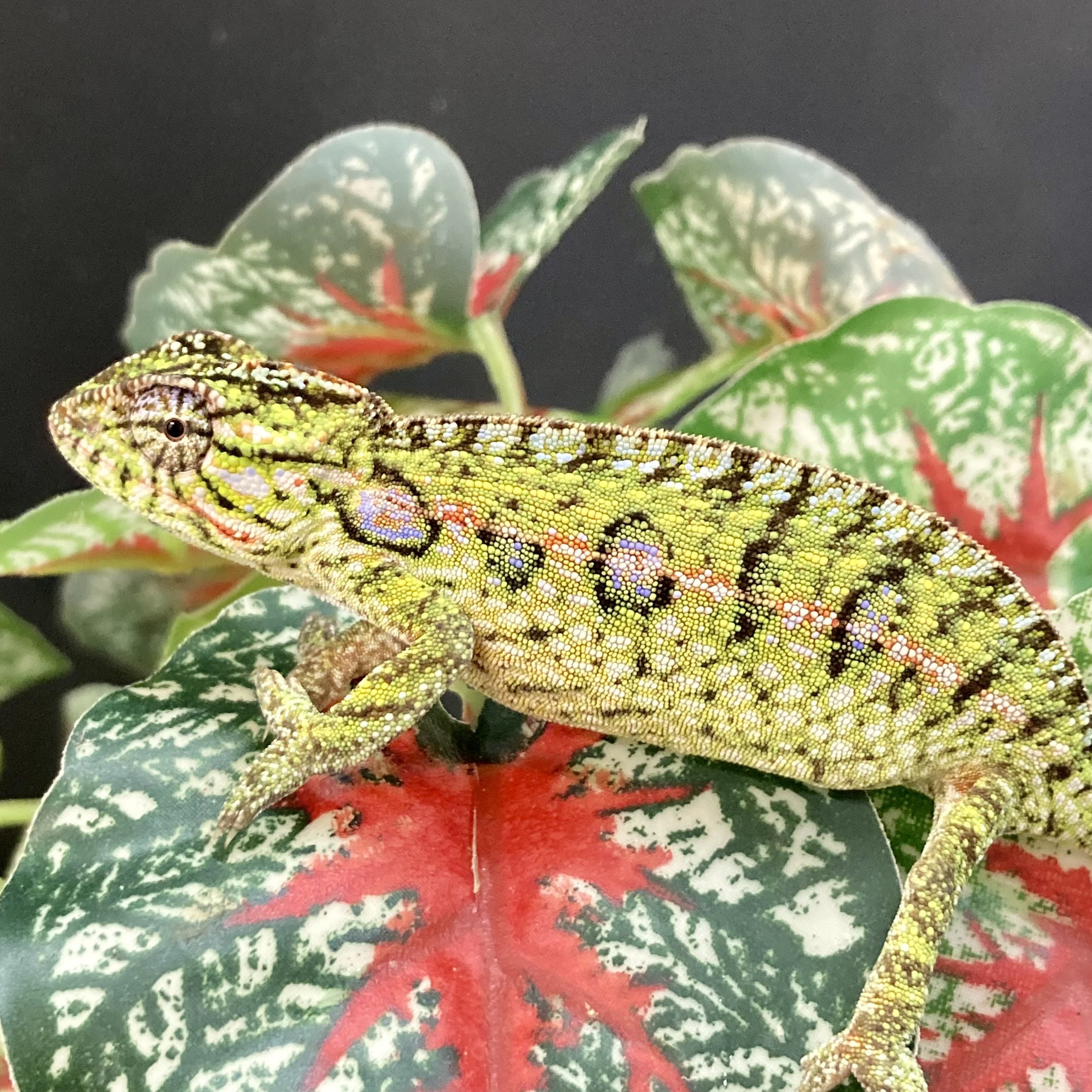Description
Also known as the Jewel chameleon, this species is considered small reaching a total length of 7-9 inches. Males are a striking green with darker markings, and females display a wider range of markings from blue to orange. Both sexes have stripy throats and lips. Lifespan of up to 4 years. Rarely seen in the trade!
Size At Present: 6cm
Minimum terrarium size for carpet chameleons
The absolute minimum enclosure size for a carpet chameleon is 18”L x 18”W x 24”H. Despite common claims that all chameleons “require” a full-mesh enclosure, it is actually better to use an enclosure with 2-3 solid sides, which can be done by covering the sides and back of a mesh enclosure with thin PVC panels. This helps retain humidity and give the chameleon a better sense of security in its home. Alternatively, you can use a well-ventilated glass enclosure, which is particularly recommended for dry climates.
Housing multiple carpet chameleons in the same enclosure is not recommended.
Do carpet chameleons need UVB?
Yes! Carpet chameleons require UVB lighting for their survival. UVB lighting helps provide a clear day/night cycle, provides all of the vitamin D that your pet needs, strengthens the immune system, facilitates better digestion, and other benefits.
Here are the best UVB bulbs for carpet chameleons:
"This is the actual animal you will receive"
- Arcadia T5 HO 6%
- Zoo Med T5 HO Reptisun 5.0
For best results, house the UVB bulbs in a reflective fixture like Arcadia or Vivarium Electronics. Make sure that the fixture your UVB bulb is housed in does not have a clear plastic bulb cover, as plastic and glass block UVB. Place the basking branch so the chameleon’s back will be 6” below the lamp.
Carpet chameleons also benefit from plant grow lights as part of their environment. Add a bright ~6500K LED or T5 HO fluorescent grow lamp to provide extra illumination, as well as help any live plants in the enclosure to thrive.
Lights should be on for 13 hours/day during summer and 11 hours/day to simulate natural seasonal cycles.
Best temperature for carpet chameleons
Carpet chameleons need a basking area temperature of 90-95°F, and between 70-75°F in the coolest part of the enclosure. Night temps should drop down to 60-70°F. Keep track of the temperatures in your chameleon’s setup with digital probe thermometers.
Provide heat for your chameleon with a halogen heat bulb placed above the basking branch. Halogen bulbs are the best way to imitate the warmth of sunlight indoors, and considered to be a superior form of reptile heating by experts. Do not use ceramic heat emitters (CHEs), red bulbs, or blue bulbs, as these are not as effective. If the bulb is too warm, reduce the heat with a lamp dimmer. If the bulb is not warm enough, you will need a higher wattage.
For best results, elevate the lamp above the top of the enclosure to create a wider basking area and more even heating.
Best humidity levels for carpet chameleons
Carpet chameleons need high humidity for good health. Aim for an average of 70% humidity during the day and higher at night. Humidity should be measured via digital probe hygrometer, with the probe placed in the middle of the terrarium.
Increase humidity by misting the enclosure every morning and night with a large pressure sprayer or an automatic misting system. You will also need a cool mist humidifier to run at night, connected to a humidistat to maintain humidity levels above 75%.
Reptile humidifiers and foggers should only be used with distilled water and require frequent disinfecting to keep your reptile from getting sick.
Best substrate for carpet chameleons
Carpet chameleons are strictly arboreal, so they don’t really need substrate to dig in or walk on. However, substrate can be a helpful way to maintain healthy humidity levels in glass enclosures. Appropriate soil substrates include ReptiSoil and Eco Earth, although the latter doesn’t work well with live plants. This substrate should be placed on top of a 1-2” layer of drainage material to prevent stagnation. Layer leaf litter on top of the substrate to further help with humidity.
If you have a mesh enclosure, you will need more water to keep things at optimal humidity, which means you’ll likely quickly saturate any substrate that you use. Instead, use a solid bottom with a drain into a large bucket. This will require some DIY, but is well worth the effort.
How to decorate a carpet chameleon terrarium
An empty enclosure makes for a bored and stressed carpet chameleon, reducing its quality of life. Keep your pet relaxed and engaged with its environment with the strategic use of décor items that encourage it to exercise natural behaviours!
You will need plenty of vines, thin branches, and foliage to decorate your terrarium. Live plants are preferable to artificial plants because of the way they help with humidity. Arrange your décor in such a way that the chameleon has somewhere to hide as needed, with an open area under the heat lamp for basking.
All climbing branches should be securely anchored to the walls of the enclosure.
What to feed to a carpet chameleon
Carpet chameleons are insectivores. This means that they only eat insects. Here’s a basic feeding schedule:
- Juveniles — as much as they can eat
- Adults — 5-6 bugs, 2-3x/week
Feeder insect options: crickets, locusts, roaches and silkworms
Make sure to offer a wide variety of insects, not just one or two different kinds!
Supplements
You will also need calcium and vitamin supplements to prevent your chameleon from developing a deficiency.
Make sure that all feeder insects are well hydrated and gut loaded prior to feeding.
"This is the actual animal you will receive"
Order and get 200 reward points
Earn points by signing up for our rewards program

